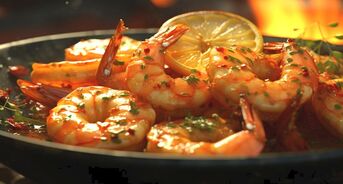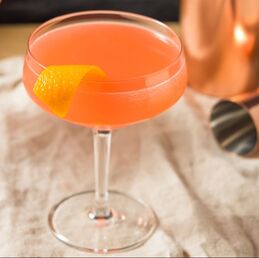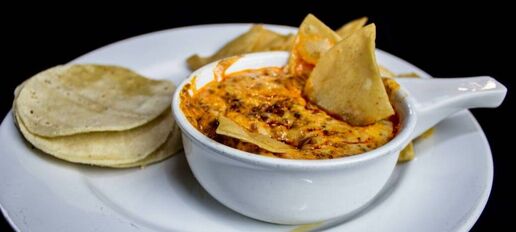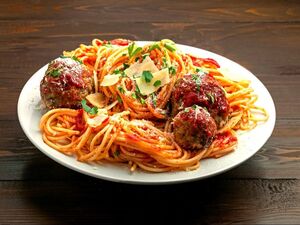…from the Perspectives’ Kitchen ow you doin’? Buckle your seatbelt, this is going to be a long one. Anybody that knows me, knows my love for doughnuts. It all started when I would collect on my paper route. There was a Winchell’s Doughnuts on Pico and La Cienega Boulevards in Los Angeles. That’s where I first met Vern Winchell who treated me to a box of a baker’s dozen. I think the intention was for me to take them home and I’m ashamed to say they never got there—I ate them all while pedaling my bike back home. The fact is I just love good doughnuts—there really is no such thing as bad doughnuts… some are just better than others. A few years back, Joan found donut pans on Amazon and gifted them to me. Since we both love doughnuts, we had a couple of sets delivered to the test kitchen. We set out to make all types of doughnuts and over the years, we have made some really good ones—all kinds of both plain and exotic flavors. I bake a batch of bran muffins weekly but realized I hadn’t made donuts for some time. I decided to make vanilla frosted cake doughnuts since they’re Joan’s favorite. I had them ready for the oven in no time and once baked, the donuts were incredibly moist and glazed to perfection. I only baked off half of the batter and had enough batter left to bake off the next morning. See the recipe toward the end of this post. But where did all these delicious pastries come from and why do some people consider them the best breakfast treat available? Well, here is the rest of the story I found in Eater Magazine authored by Claudia Geib. As she explained it, even during the worst of war, the ring-shaped confections offered a bite of joy and a much-needed morale boost to weary soldiers during World War I. Dough fried in oil is a delicacy found worldwide… in Italy it’s zeppole, from Greek loukoumades to Moroccan sfenj to jalebi in India and Pakistan. But in North America at the start of the 1900s, fried dough balls were a regional specialty mostly confined to New England, New York and a few places in the Midwest. Just 50 years later, doughnuts would be Americans’ treat of choice—ubiquitous in break rooms, beloved of cops and, more recently, made fancy by hipsters. But few people know that the doughnut might never have made it big without a world war or two. In a new episode of Gastropod, “Raised and Glazed,” co-hosts Cynthia Graber and Nicola Twilley explore the evolution of the doughnut… where the name comes from, how it got a hole and how it became ubiquitous across the United States thanks to the efforts of a few female volunteers working on the front lines of global conflict. When the United States joined World War I, the Salvation Army sent women to the front in France with a few simple instructions: Lead the men in prayers; play music; comfort the wounded and the dying; and, most importantly, do whatever they could to keep up morale. Conditions on the Western Front were grim. As Salvation Army leader Evangeline Booth recalled in her memoirs of the war, the rain had combined with heavy bombing to turn the entire landscape into a swamp, and “depression like a great heavy blanket hung over the whole area.” The women made cocoa, fudge, and apple pies to lift men’s spirits. But pies were difficult to make — achieving a flaky crust was tricky in the trenches — and sometime in late September 1917, Salvation Army volunteer Helen Purviance suggested focusing on a simpler treat. She and her colleagues could combine flour, sugar, baking powder, salt, eggs, and milk to make doughnut dough. Then they could fry their creations in a steel soldier’s helmet filled with boiling lard. The front cover of the songbook for “My Doughnut Girl” displays a girl who appears to be in her mid-teens carrying the doughnuts that rose to fame during the war effort were originally made with one goal in mind: Maintaining morale. New York: The Salvation Army National Headquarters, [1919] /Library of Congress, Music Division. The women rolled the doughnuts out with a grape juice bottle, cut them out with a baking powder can, and poked a hole in the middle using a funnel. Dusted with powdered sugar and handed out hot by the thousands, the treats produced by the “doughnut Sallies,” as the women soon became known, instantly became a hit among the men. Even for men who hadn’t come from a doughnut-loving region of the States, the fried rings came to symbolize everything good and comforting. “Newspapers would describe the soldiers looking through the hole in the donut and seeing their mother on the other side,” Michael Krondl, author of The Donut, told Gastropod. “It was a beautiful thing.” Though the Salvation Army only sent 250 volunteers to the front, these women had a disproportionate impact on the soldier’s psyche; the treats “put pep in every doughboy,” Salvation Army Colonel William Barker told a reporter from the Boston Daily Globe. “Every doughboy felt his mother was somewhere just back of the lines in the midnight mists and damps, frying doughnuts for him just as she used to do.” (Incidentally, the “doughboy” moniker originated from the Mexican-American War, and it had nothing to do with doughnut consumption at all.) It got to the point that military command would pull strings to ensure that donut-making supplies made it through, despite the fact that the French were surviving on black bread. “The American soldiers take their hats off to the Salvation Army,” wrote a New York Times correspondent in 1918, “and when the memoirs of this war come to be written the doughnuts and apple pies of the Salvation Army are going to take their place in history.” Even men who didn’t come from doughnut-loving regions of the United States were willing to sing the praises of doughnut girls and their creations. Popular culture brought this newfound love of doughnuts back home. Songs like “My Doughnut Girl” and films like Fires of Faith, which featured scenes of a Salvation Army Sally distributing doughnuts to bedridden men, helped cement the doughnut’s new status as an American icon. Doughnut entrepreneurs popped up, ready to supply a nation suddenly hungry for the treats feeding the troops, and companies advertised mixes that allowed the home baker to make doughnuts themselves. When fighting ended, the Salvation Army continued to sell doughnuts to raise money through the 1920s and the Great Depression; and when war broke out again in Europe, volunteers from both the Salvation Army and the Red Cross once again brought doughnuts to the front. They were assisted by a newfangled invention: an automatic doughnut-making machine, which allowed doughnuts to be made faster and in greater quantities than ever before. Post-war, doughnuts continued their spread across the country, fitting perfectly with the newly industrialized landscape, the rise of the automobile, and the growth of women in the workforce. For a whole new class of car-based commuters, a doughnut shop became the perfect place to stop for coffee and a sweet circular cake for breakfast. If you like donuts as much as I do, try my recipe out. If you don’t have a donut pan, I highly recommend getting one, but you can also pipe the batter into circles on a sheet pan as a less-expensive substitute. Ingredients For the doughnuts 1 cup all-purpose flour 1/2 cup granulated sugar 1/4 cup unsweetened cocoa powder 1/2 teaspoon baking soda 2 teaspoons pure vanilla extract 1 large egg 6 tablespoons sour cream 1/4 cup whole milk 1/4 cup vegetable oil For the vanilla glaze 2 cups confectioners’ sugar 6 tablespoons whole milk 1 teaspoon pure vanilla extract Directions To make the doughnuts
To make the glaze
ChefSecret: If you find yourself in the Las Vegas area the best and most creative doughnuts can be found at Pink Box. Be creative as they are and decorate your doughnuts with all kinds of goodies. Quip of the Day: Knock Knock. Who’s there? Donut. Donut who? Donut ask, it’s a secret! ------------------------------------------- Do you have a question or comment? Send your thoughts to [email protected]. All recipes and cooking tips are posted on our website https://www.perspectives-la.com/covid-19-survival-guide. ------------------------------------------- To you and everyone dear to you, be strong, positive, stay well, stay safe and be kind. Take a breath and count your blessings, and if you have a little extra to share with others, please consider donating to Feeding America, Tunnel to Towers, Union Rescue Mission and/or American Red Cross. #Baking #Treat #Dessert #Donut #PinkBox #BakedDonuts #FriedDonuts #GlazedDonuts #ChocolateDonuts #2024Recipes #URM #T2T #FeedingAmerica #RedCross #PerspectivesTheConsultingGroup ©PERSPECTIVES/The Consulting Group, LLC, 2024
0 Comments
…from the Perspectives’ Kitchen How you doin’? When I’m in a pinch for time, I make something with shrimp. For all its quick-cooking ease, shrimp always makes any meal a bit special. This skillet recipe is no exception. It finishes with its dark red glaze, slivers of green onion, and wheels of charred Meyer lemon. It is a gourmet dish with rustic flavor back notes… the shrimp tastes amazing with a wonderful texture (if you don’t overcook them) that just might replace buffalo wings for happy hour. It’s the charred Meyer lemons that make this dish such a standout and while they may seem like a fancy ingredient, making them is as simple as sliding halved lemons under the broiler for 10 to 15 minutes. That little bit of concentrated heat imparts so much depth of flavor and sweet complexity… it’s one of my favorite kitchen techniques. Once the juice from the charred lemons marries with the other ingredients, wonderful things happen. The honey and sambal oelek, brightened by the citrus notes, make a sweet-savory glaze that clings to the shrimp and creates a delightfully crunchy, sticky caramelized exterior. Prep time: 15 minutes Cook time: 10 minutes Servings: 4 to 6 Ingredients 1-1/2 pounds extra jumbo shrimp (16-20 count), peeled and deveined 1/2 teaspoon kosher salt 1/4 teaspoon freshly ground black pepper 1/4 cup unsalted butter 1/4 cup honey 3 charred Meyer lemons, divided 1 teaspoon low-sodium soy sauce 3 tablespoons minced garlic 2 teaspoons sambal oelek 1 teaspoon vegetable oil 2 tablespoons minced green onion bottoms, plus more sliced tops for garnish Optional: Serve with steamed rice and your favorite vegetables on the side. Directions
ChefSecret: The sturdy glaze helps the shrimp hold up well for day-after bowls, salads, and tacos. Slice those leftover lemons into julienned strips and use them to add a bit of extra punch to your leftovers. Can’t find Meyer lemons? Just use 1 regular lemon and 1 lime. Quip of the Day: Q. What do you call a store where you negotiate for off-the-book shrimp transactions? A. Prawn Shop ------------------------------------------- Do you have a question or comment? Send your favorite recipes, pictures or thoughts to [email protected]. Recipes and cooking tips are posted on our website https://www.perspectives-la.com/covid-19-survival-guide. ------------------------------------------- To you and everyone dear to you, be strong, positive, stay well, stay safe and be kind. Take a breath and count your blessings, and if you have a little extra to share with others, please consider donating to Feeding America, Tunnel to Towers, Union Rescue Mission and/or American Red Cross. #Entree #MeyerLemonHoneyShrimp #Shrimp #MeyerLemon #Honey #Dinner #2024Recipes #URM #T2T #FeedingAmerica #RedCross #PerspectivesTheConsultingGroup ©PERSPECTIVES/The Consulting Group, LLC, 2024 …from the Perspectives’ Happy Hour Bar How you doin’? Here’s a strange Happy Hour cocktail dating back to Prohibition. I selected the Monkey Gland because it's a great drink, but I also chose it for its back story. Consider serving this one up at your next party, just so you can entertain your guests with a funny historical anecdote. The Monkey Gland is a Prohibition classic, devised at Harry's New York Bar in Paris in the 1920s. The name is a reference to a surgical procedure by Dr. Serge Voronoff. For men with performance issues, Dr. Voronoff offered to implant in them the testicle of a monkey, for "rejuvenation," as he called it. That would make your George very curious indeed. In 2024, if you're an adult male who feels the need for a little, um, assistance in the intimacy department, you reach for one of the blue pill pharmaceuticals you see advertised during football games. In 1928, if you needed a little vavoom in the bedroom, you went to see Dr. Voronoff. So popular was Voronoff's vitality procedure in the 1920s that it inspired the creation of the Monkey Gland, a cocktail named for the rather sensitive part of an unfortunate simian's anatomy that Voronoff surgically implanted into his eager patients. This is a drink where purchasing the right ingredients makes all the difference. Fresh-squeezed orange juice is essential and a quality grenadine—Stirrings makes a decent one and an authentic absinthe really make the cocktail come together (though a substitute such as Herbsaint, Pernod or Ricard will also suffice). Did Voronoff's treatment work? No, not really—and one doesn’t have to guess how the castrated monkeys felt about the whole thing. One picture above is worth a thousand words. Fortunately, the cocktail still does the trick and you don’t need to de-ball any monkeys in the making of this cocktail. Prep time: 3 minutes Yield: 1 cocktail Ingredients 1-1/2 ounces gin 1-1/2 ounces freshly squeezed orange juice 1 teaspoon grenadine 1 teaspoon absinthe Directions
ChefSecret: Can’t find a good absinthe? You can use Herbsaint, Pernod or Ricard as a substitute. Quip of the Day: Life is like the monkey bars… you have to let go to move forward. ------------------------------------------ Do you have a question or comment? Send your thoughts to [email protected]. All recipes and cooking tips are posted on our website https://www.perspectives-la.com/covid-19-survival-guide. ------------------------------------------- To you and everyone dear to you, be strong, positive, stay well, stay safe and be kind. Take a breath and count your blessings, and if you have a little extra to share with others, please consider donating to Feeding America, Tunnel to Towers, Union Rescue Mission and/or American Red Cross. #Cocktail #MonkeyGlandCocktail #Gin #OJ #OrangeJuice #Grenadine #Absinthe #MarchMadness #Cheers #HappyHour #2024 #T2T #URM #FeedingAmerica #RedCross #PerspectivesTheConsultingGroup ©PERSPECTIVES/The Consulting Group, LLC, 2024 …from the Perspectives’ Kitchen How you doin’? A couple of weeks ago we met a client at a new age Mexican restaurant called Borracha located at Green Valley in Henderson, NV. They have a diverse menu of delicious Mexican entrees, but at Borracha, queso is the star of the show! What is Queso Fundido (emphasis on FUN)? It is nothing less than fondue with a south-of-the-border accent! Queso Fundido is not only fun to eat but fun to make, too. Picture this… a pot of sharp and flavorful cheese that looks and smells so scrumptious melting on the stove. I thought about skipping the part where it gets bubbly in the oven and going straight for the chips. And yet, the real beauty of this dish is all the interesting stuff going on below the surface of the cheese—every bite is full of chewy, spicy chorizo, crunchy Anaheim peppers, and tangy onion—almost the same as Borracha. Crisp corn tortilla chips are the classic vehicle for scooping up Queso. That said, Queso also tastes amazing wrapped up in a warm flour tortilla—it’s like a super fancy quesadilla. Prep time: 10 minutes Cook time: 10 minutes Bake time: 10 minutes Ingredients 4 ounces spicy ground chorizo 1 cup minced sweet yellow onion 1 Anaheim pepper, seeded with ribs removed and cut into long strips 2 cups shredded whole milk mozzarella cheese 2 cups shredded sharp white cheddar 1/2 teaspoon kosher salt 1/2 cup heavy cream 1/4 cup chopped cilantro 2 thinly sliced radishes (optional top garnish) Warm salted corn tortilla chips for scooping Directions
ChefSecret: Queso Fundido is the perfect snack for a last-minute Friday Happy Hour or a March Madness watch party. It comes together in about 20 minutes and perhaps more importantly, it pairs remarkably well with a cerveza fria (cold beer). A crisp, clean Modelo Especial will cut right through all that gloriously salty cheese and leave your palate ready for the next bite! I personally like a Grit—a premium margarita made with Patron tequila—stirred and not shaken. Quip if the Day: Q: What do you call cheese that isn’t yours? A: Nacho cheese! ------------------------------------------- Do you have a question or comment? Send your thoughts to [email protected]. All recipes and cooking tips are posted on our website https://www.perspectives-la.com/covid-19-survival-guide. ------------------------------------------- To you and everyone dear to you, be strong, positive, stay well, stay safe and be kind. Take a breath and count your blessings, and if you have a little extra to share with others, please consider donating to Feeding America, Tunnel to Towers, Union Rescue Mission and/or American Red Cross. #Entree #Appetizer #QuesoFundido #Queso #CheeseDip #Cheese #TortillaChips #MarchMadnessSnacks #Dinner #2024Recipes #URM #T2T #FeedingAmerica #RedCross #PerspectivesTheConsultingGroup ©PERSPECTIVES/The Consulting Group, LLC, 2024 Ancient Scrolls from Almost 2,000 Years Ago How you doin’? In my last book I talked about the importance to mankind of food and drink to culture. “The Anthropology of Man Can Be Traced More Accurately Through the Foods & Beverages Of Time Rather Than Just The Richness Of Art, The Prose Of Literature, The Rhythm Of Music Or The Structure Of Architecture.” Well, listen up… an ancient scroll from almost 2,000 years ago has finally been decoded. Quite the step up from the bits of hieroglyphics we ‘learned’ in high school Ancient Egypt classes, this task needed the help of artificial intelligence (AI) to be worked out. The Herculaneum papyri are made up of about 1,800 scrolls and ended up buried in ash after Mount Vesuvius erupted in 79AD. These scrolls were excavated from an ancient Roman villa, but it’s been an absolute slog trying to unroll and read them. So, the Vesuvius Challenge was set up in March 2023 to try and decode them, offering a mega prize pot of $1million to crack the code. Papyrologists (yes, they’re a real thing) worked with the contest, believing the Roman scroll contains ‘never-before-seen text from antiquity’. Might it be politics, religion, pros, poetry or maybe something else? Three students managed to read 15 columns in a scroll, helped out by AI-powered coding machines. Youssef Nader in Germany, Luke Farritor in the US, and Julian Schilliger in Switzerland will get to share the $700,000 prize money after managing to read over 2,000 letters. Nat Friedman is one of the challenge’s organizers and TIME reports that after printing out the winning submission he said: “All this has been in this dreamlike digital world in my imagination before. Seeing it on paper, rolling it up, it just made it so tangible.” This winning submission totals four passages, each of 140 characters. TIME explains: “With at least 85% of the characters in each of those passages recoverable by professional papyrologists. It also contains a further 11 columns of text.” The text in question is a piece of Epicurean philosophy on the subject of cuisine pleasure… that’s right, Epicurean philosophy! The winning submission shows ancient Greek letters on a large patch of scroll, and the author seems to be discussing the question: are things that are scarce more pleasurable as a result? The scrolls were excavated from an ancient Roman villa, Herculaneum. The author, whose identity is unconfirmed, doesn’t think so: “As too in the case of food, we do not right away believe things that are scarce to be absolutely more pleasant than those which are abundant,” one passage from the scroll reads. In the final section of the scroll, the author appears to criticize his intellectual adversaries, who 'have nothing to say about pleasure, either in general or in particular, when it is a question of definition'. Professor Alice Roberts dubbed this discovery ‘the archaeological discovery of my lifetime’. Although, there is yet a whole load to be discovered with the combined efforts of the Vesuvius Challenge resulting in about five percent of one scroll being read. And the contest confirmed on X: "In 2024, our goal is to from reading a few passages of text to entire scrolls, and we're announcing a new $100,000 grand prize for the first team that is able to read at least 90% of all four scrolls that we have scanned." So, what might they have discovered—a recipe for spiced, Roman-Style Meat Balls? Roman Meatballs with Pompeiian Tomato Sauce Prep time: 25 minutes Cook time: 40 minutes Total time: 1 hour 5 minutes Ingredients For the meatballs 1/2-pound lean ground beef 1/2-pound ground pork 1 cup Italian seasoned breadcrumbs 1/2 cup Italian grated Parmesan cheese 2 tablespoons fresh chopped Italian parsley 4 cloves minced garlic 2 large eggs, lightly beaten 1 teaspoon kosher salt 1/2 teaspoon black pepper olive oil (for browning the meatballs) For the sauce 1/2 cup virgin olive oil 1 medium finely diced yellow onion 4 cloves garlic, whole 1-28-ounce can of San Marzano Italian-style tomatoes (imported from Italy) 1-28-ounce can of tomato purée 3 tablespoons freshly chopped Italian parsley 2 teaspoons dried thyme kosher salt to own taste fresh ground black pepper to own taste Accompaniments 1-pound dried spaghetti extra chopped parsley for serving Fresh basil added options red pepper flakes for serving grated Pecorino Romano Directions To make the meatballs
To put it all together
Chefs Secret: No need to add olive oil to the drained pasta… you’ll just end up with unnecessarily oily pasta. Quip of the Day: After a long day of conquering, Julius Caesar liked to unwind with a nice Roman-ade. ------------------------------------------- Do you have a question or comment? Send your thoughts to [email protected]. All recipes and cooking tips are posted on our website https://www.perspectives-la.com/covid-19-survival-guide. ------------------------------------------- To you and everyone dear to you, be strong, positive, stay well, stay safe and be kind. Take a breath and count your blessings, and if you have a little extra to share with others, please consider donating to Feeding America, Tunnel to Towers, Union Rescue Mission and/or American Red Cross. #Entree #RomanMeatballs #SpaghettiAndMeatballs #PompeiianTomatoSauce #HerculaneumPapyri #Dinner #2024Recipes #URM #T2T #FeedingAmerica #RedCross #PerspectivesTheConsultingGroup ©PERSPECTIVES/The Consulting Group, LLC, 2024 |
For over 4 decades collaboration and vision have been the cornerstones of our approach to developing innovative solutions. We fuel innovation, uncover opportunities, discover trends and embrace sustainability, turning imaginative ideas into profitable realities. Categories
All
Archives
July 2024
|
www.perspectives-la.com
Copyright © 2021 Perspectives/The Consulting Group, LLC | Henderson, NV 89052 | 310-477-8877
Copyright © 2021 Perspectives/The Consulting Group, LLC | Henderson, NV 89052 | 310-477-8877


 RSS Feed
RSS Feed